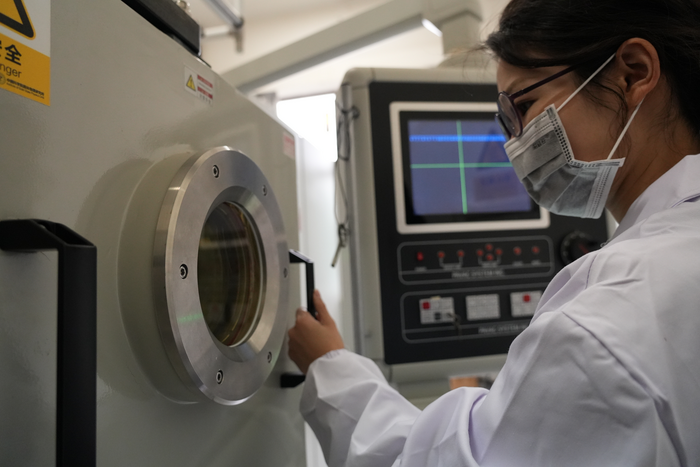A research group has recently performed an investigation into the relationship between microstructure evolution and property degradation of two representative second-phase dispersion-strengthened tungsten materials following electron beam thermal loading.

Researcher doing an experiment on EBMP-30 equipment. Image Credit: ZHAO Weiwei.
The study was performed by a research group from the Hefei Institutes of Physical Science (HFIPS), Chinese Academy of Sciences (CAS).
The associated research was reported in the Journal of Materials Science & Technology.
Plasma-facing tungsten (W) materials in the magnetic confinement nuclear fusion devices have been exposed directly to high-temperature plasma and are normally subjected to transient thermal shocks of ~1 GW/m2 and steady-state thermal loads of 5 to 20 MW/m2. This can help increase the surface temperature of tungsten to more than 1800 ℃.
The elevated heat flux load to W results in some irreversible material damages, like surface cracking, roughening, and surface melting. Hence, it is pressing to assess the thermal load resistance of W materials.
In this study, scientists performed repetitive heat loads on an electron beam device, the Electron-beam Material-research Platform (EBMP-30), up to 30 kW. This platform was built to calculate the thermal shock resistance of plasma-facing materials (PFMs).
“It adopts a 30 kW welding electron beam with a maximum acceleration voltage of 100 kV," it can scan 30 × 30 mm2 area with maximal frame rate of 35 kHz, and its pulse duration can change from 100 ms to a continuous state,” explained XIE Zhuoming, who assisted in building the platform.
Depending on the EBMP-30 device, two representatives W-0.5 wt% ZrC (WZC) and W-1.0 wt% Y2O3 (WYO) composites were chosen to learn about the damage behavior induced by recurrent steady-state heat loads, with an absorbed power density (APD) in the range of 10 to 30 MW/m2.
The outcome shows that the tensile and microstructure properties of WZC and WYO specimens do not change considerably when APD ≤ 20 MW/m2. But when APD ≥ 22 MW/m2, grain growth and full recrystallization in WYO specimens and Y2O3 particle shedding from the W matrix were detected.
Furthermore, the eventual tensile strength and total elongation of WYO went down from 861 MPa to 510 MPa and from 15% to near zero, respectively.
Due to the different coefficients of thermal expansion (CTEs) of the Y2O3 phase and W, irreversible plastic deformation of the W matrix occurs, especially around the coarse Y2O3 particles which leads to the interface debonding between Y2O3 particles and the W matrix.
Xuebang Wu, Study Lead Author, Hefei Institutes of Physical Science, Chinese Academy of Sciences
Following thermal loads at 22 MW/m2, WZC specimens retained the high ultimate tensile strength of 816 MPa as a result of their high recrystallization temperature (approximately 1300 ℃).
The fine and uniform distribution of ZrC particles and its comparable CTE to the W matrix which effectively avoids ZrC particle shedding and the formation of microcracks.
Xuebang Wu, Study Lead Author, Hefei Institutes of Physical Science, Chinese Academy of Sciences
Wu added, “This study reveals the correlations between the microstructure evolution and performance degradation in two representative second-phase dispersion strengthened tungsten materials, as well as the mechanism of fatigue damage by high thermal loads which provides an important reference for the further development of high-performance tungsten materials.”
Journal Reference
Wang, H., et al. (2022) Microstructural evolution and thermal fatigue damage mechanism of second-phase dispersion strengthened tungsten composites under repetitive thermal loads. Journal of Materials Science & Technology. doi.org/10.1016/j.jmst.2022.09.007.